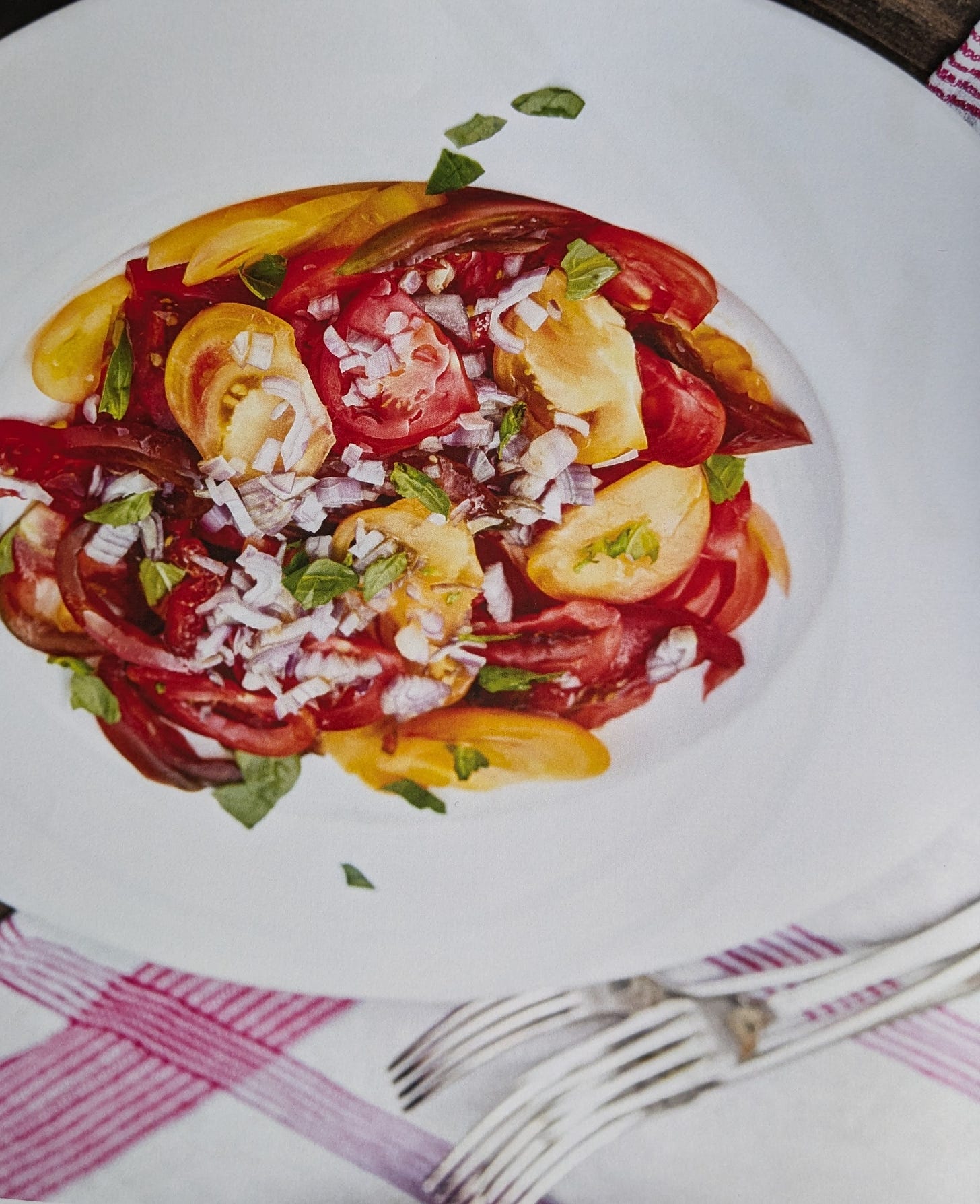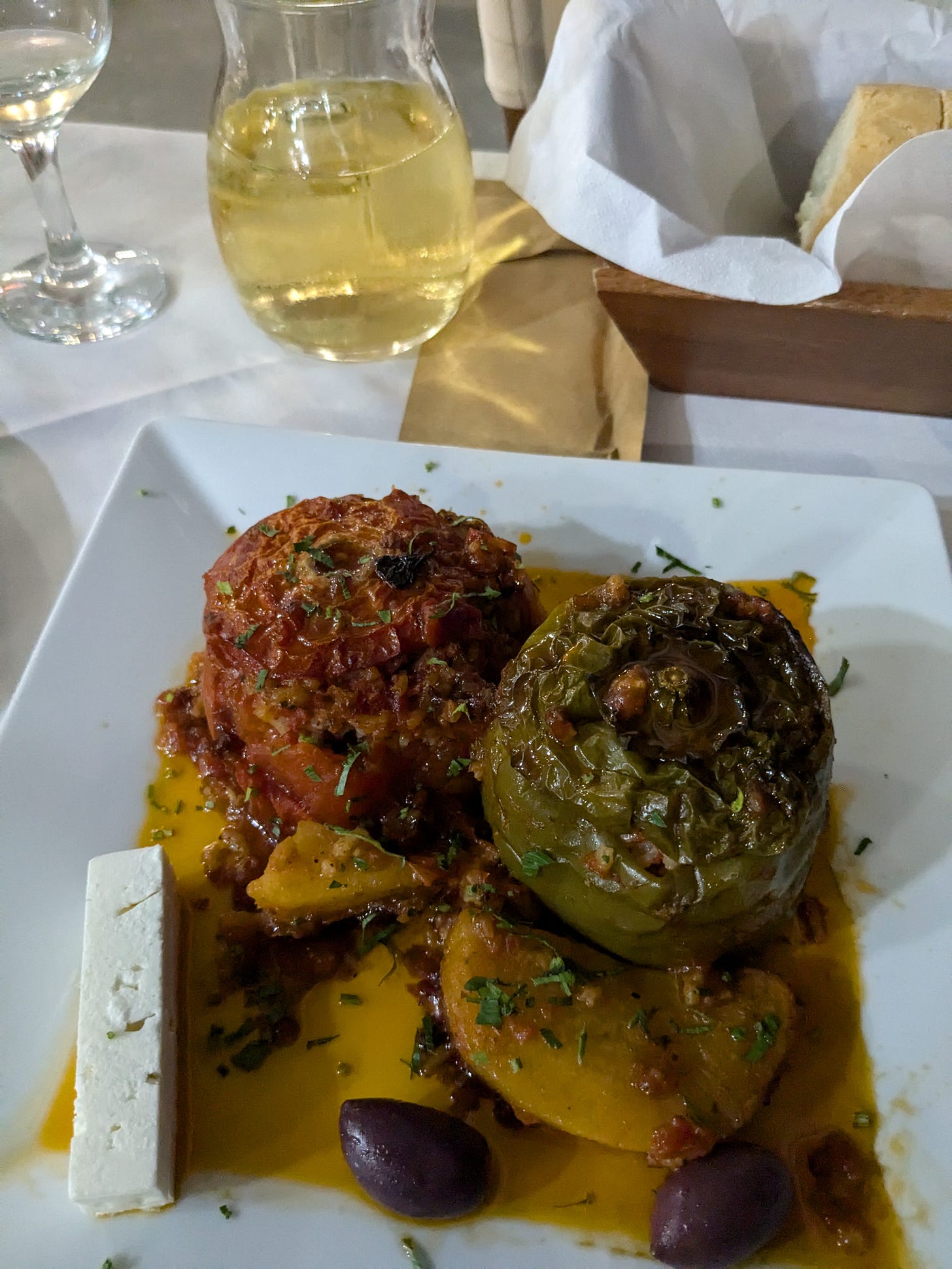

Like love itself, the love apple can be a splendid thing or a sad disappointment. In Greece on a recent trip, the tomatoes were the latter. Once upon a Hellenic time, when eaten on a beach like a peach, the fruit (yes, it’s a fruit, defined by the fact it grows from a flower and contains seeds) oozed its tomato juices down the sunburnt chin. These days, it’s more likely to present a crunch to the teeth, and flatness of flavour.
Greeks with a plot or a balcony will grow as many of their own tomatoes and other vegetables as they can. The more remotely they live, the more likely their varieties will be of ancient origin, and full of flavour. But to keep supply high, to reduce dependence on water, to control pests and diseases, the Greek Ministry of Agriculture has promoted the use of poly-tunnels for trade supply. That’s how the majority of tomatoes are grown by the commercial tomato farmers of Central Greece, Epirus, the Peloponnese, Macedonia, Thessaly, the Aegean Islands, and Crete - and growers of other countries. With one exception.
I’ve said it on Tabled before: raw commercial tomatoes just don’t hack it in a salad. If you want a tomato as one should taste, fly at once to Georgia (No. Definitely not the US state). Even where the soil is degrading through erosion, pollution and infrastructural development, vegetables sold in local produce stores or served in restaurants are more often than not grown on family farms and individual plots that historically have been created from organic and well-structured soil. Tomatoes in Georgia are unlike any others anywhere – deep crimson, scented, juicy juicy juicy. (The flavour of their cucumbers beats even Persian mini cucumbers into a cocked hat. Ditto pretty much all other Georgian vegetables and fruits.)
44.4 million tons of tomatoes globally were produced in 2023, a market worth $195.34 billion. Just as peas are better frozen than fresh, unless you’re growing your own, any tomatoes other than those that benefit from a hot and regular sun are best in cans.
After the United States and China, Italy is largest producer of tomatoes for processing, and Emilia Romagna the region with the highest production at 1.9 million tons in 2023. Puglia in the south isn’t far behind, with 1.6 million tons, followed by Agro Nocerino Sarnese, a low-lying region in Campania between Salerno and Naples where the very best tomatoes are those grown in the volcanic soil of volatile Mount Vesuvius, the San Marzano variety. It contains less water and fewer seeds than other varieties. Sicily, home of relatively safe volcano Mount Etna, is a second top source.
As far as I'm concerned, tomatoes, like strawberries, represent what we've abandoned in our food expectations. Because we want what we want right this minute, we take the cocktail hour sun-over-the-yard-arm-somewhere approach to the tomato, sacrificing flavour in favour of having it now when we shouldn’t, because it’s just not in season where we are.
It applies to so much of what we now expect to be able to eat, even when it doesn’t taste as it should. I recently roasted a pricey chicken that had lived happy days freely scratching in and out of Mrs Wilkinson's kitchen until she deemed it time to deliver it to the local butcher. The table tucked in. There was silence. “What is this bird?” “It’s a chicken.” “No, it's not.” When I took my own bite, I understood. Its intense flavour rocketed me right back to the days when chickens, all genuinely free range, were too expensive for anything but special treats.
In Washington DC, I used to shop for my fruit and veg in the suburbs not downtown, because the people who came from different nations to live there would toss unsatisfactory produce onto the floor with contempt. The Korean supermarkets knew to stock only produce at its peak if they were to maintain their profit margins. And because their customers could generally depend on them for quality, stock turnover was rapid. British supermarkets have devised a canny marketing conceit for produce shipped while still green so less likely to spoil: ‘For home ripening’. If, en masse, we stopped buying unripe or unseasonal produce, supermarkets might begin to take note. We might get the tomatoes, the strawberries, the poultry we deserve. Consumers do have power. For some reason, we elect not to use it.
The closing of the fresh tomato season is just around the corner. Make the most of any that promise full flavour. If the tomatoes you buy are in prime form, slice them in half across then grate them on the largest holes of a cheese grater, discarding the skin, for a fresh tomato sauce that you fold into penne with torn chunks of mozzarella, which melts into the hot pasta, and torn leaves of basil.
If they are colourful heirlooms, slice them into a salad. Heirloom tomatoes are varieties which have been grown without crossbreeding for a minimum of 40 years. Typical supermarket tomatoes are hybrids that have been crossbred to create characteristics such as regularity of size and colour, resistance to disease, and thick skin so they can travel without damage. Flavour doesn’t seem to have been on the list.
This is a simple salad that celebrates heirlooms. It’s scattered lavishly with finely chopped red onion which you’ve soaked in iced water for 10 minutes to remove any astringency then drained. Sprinkle with sea salt, drizzle with oil and a modicum of vinegar if you want, but allow the tomatoes’ juices to provide most of the acid. The best cook I know blanches and peels her tomatoes before making a tomato salad. I confess it makes a big difference. But I don’t do it.
If your local tomato supplier is only the supermarket, just cook them. That will bring out what flavour they have. At the simplest, buy cherry tomatoes, or small plum tomatoes and halve them lengthways. Decant them into a baking dish where they’ll sit tightly, with a few cloves of peeled garlic distributed among them. Dose them in olive oil and sprinkle over sea salt and a teaspoon of sugar, then bake them in a 180C/350F oven for 30-40 minutes until they begin to caramelise or even char a little. Tear some basil over and serve as a side dish to pretty much anything, or fold them into cooked spaghetti and eat with grated Parmesan. Alternatively, leave them to reach room temperature and sprinkle with toasted pine nuts and drizzle over a very little mustardy vinaigrette (there's the oil you roasted them in, remember) and serve with crusty bread.
If you can find large tomatoes, stuff them. This recipe also works with peppers.
The filling is enough for 6 large or 12 medium tomatoes
1 cup olive oil
3 cups chopped onions
1 fennel bulb, trimmed and finely chopped
1 tablespoon fennel seeds, freshly ground
1 cup Arborio rice
1 cup each of fresh dill and fresh parsley, roughly chopped
½ cup fresh mint leaves, finely chopped
salt and pepper to taste
1 large potato, peeled, halved across, then cut into wedges
Preheat oven to 190C/375F.
Slice off the top of each tomato to create a lid. Carefully scoop out the contents and chop.
Saute the onions and fennel in ½ cup of the oil over medium-low heat till soft, about 5 minutes. Add the fennel seeds and rice and saute, stirring regularly, for 2-3 minutes then pour in the tomato pulp. Reduce the heat to low and stir 3 minutes more. Fold in the herbs and cook 2 more minutes. Remove from the heat and season to taste.
Stuff the tomatoes but not to the top so the rice can expand. Cover with the tomato lids. Stand them in a baking dish, slide the potato wedges between them, season well, and pour over the tomato pulp and remaining olive oil. Bake for an hour or until the rice is cooked through. Check under one lid. Turn off the oven and leave the tomatoes for 10 minutes then cool to room temperature to serve.




This was the perfect thing to read whilst eating the last of my home grown tomatoes on local sourdough for breakfast!
I’m with you on Georgian tomatoes. From initial bite chasing down wine on first tour in 2012